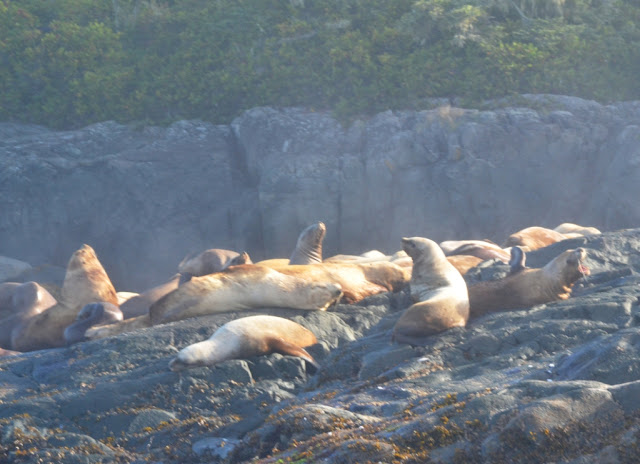It was a bit chilly on the water, and we were wondering if we would be able to see anything with the fog, but were distracted with hot tea and coffee and fresh-baked muffins from the galley below.
After 15 or 20 minutes of sailing, and just as the sun was beginning to penetrate the fog, we passed a small island with a group of Steller Sea Lions.
The bulls were busy posturing and bellowing, and the cows were just catching some rays. The one in the foreground looks very relaxed.
The Steller Sea Lion as well as the Steller's Jay and several other species native to BC, are named for Georg Wilhelm Steller, the German botanist and zoologist who explored Siberia and Alaska in 1740 and 1741 as a member of Vitus Bering's second Kamchatka expedition. On the return voyage they were shipwrecked on what is now Bering Island. Bering and about half the crew died in the aftermath of the wreck. The remaining crew managed to construct another boat and sailed it back to Siberia. Steller himself died two years later on his return voyage to Europe.
A short time later we entered Blackfish Sound, a body of water about 10 km or so wide, defined by a perimeter of several islands. We heard this humpback blowing and then it emerged out of the fog.
Before long we found ourselves in the midst of what seemed like ten or a dozen whales feeding throughout the sound, some near and some in the distance.
Apparently humpbacks can stay submerged for up to 45 minutes, but usually come up to breathe every 5 or 10 minutes. I noticed, in a few instances, that a whale would surface 2 or 3 times in fairly quick succession without showing it's tail, and then, on the final dive it's fluke would appear just before it went under and we wouldn't see that individual again, for a while anyway.
The narrow arch of it's back was telling me this whale's tail would come out of the water just before it disappeared.
Apparently each whale has unique markings on the flukes, and this is a way to identify individuals.
This is a Common Murre, one of the many birds hanging around where the whales were feeding - picking up scraps brought to the surface, maybe?
I finally clued in to what the term "sea smoke" means. Here a couple of whales are blowing simultaneously on the far side of the sound.
Humpbacks were hunted to the brink of extinction until a moratorium was introduced in 1966. Since then the population has been recovering worldwide, but they have only returned to the Johnstone Strait area in the past decade or so.
A beautiful day and a beautiful setting for hanging with the humpbacks.
There was one other (bigger and more crowded) whale-watching boat in the sound, but we rarely got close to them.
A couple of our fellow passengers. This couple was from Switzerland and there was another group from Great Britain and I think the rest were Canadian.
Twice, TWICE!! one whale breached, that is launched itself right out of the water and fell back in with a mighty splash, not far from our boat. I was looking the other way both times :(
I had to console myself with fresh-baked scones, jam and Devonshire Cream
All too soon we watched the last fluke slip beneath the sea, and headed back to the harbour.
This whale was navigating through the same narrow passage between islands that was part of our route back.
Back at the dock, and one last look back at the Tuan after a spectacular and moving day among the whales.
Next time - Cape Scott and more ...





















No comments:
Post a Comment